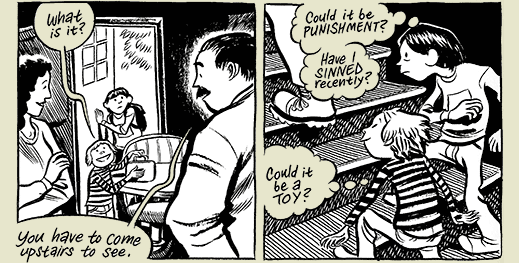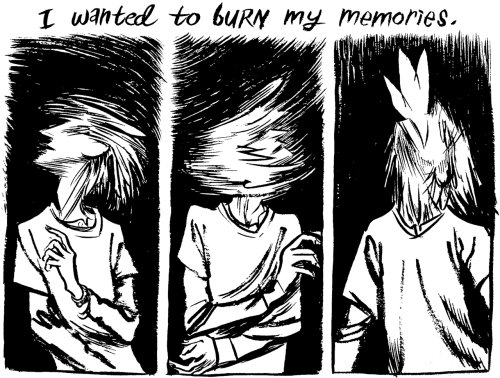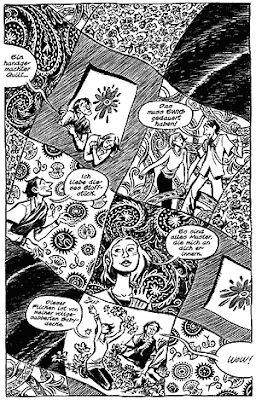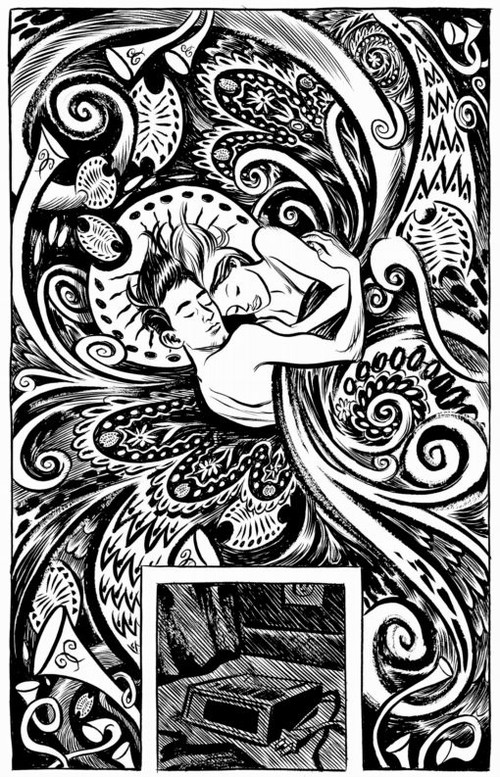
By Craig Thompson
- Craig Thompson: Craig is the main character, who is depicted from childhood to a young adulthood. Craig struggles with his Christianity, and with his belief that the Christianity that he has been surrounded with his whole life is not what he believes it should be. At a Baptist Christian winter camp he meets a girl from a similar background named Raina who becomes his first love.
- Phil: Craig's younger brother. Like Craig, he likes to draw, and the first portion of the story details their childhood together, though they later drift apart. Their adventures are also recalled at least once in each chapter throughout the book.

- Raina: Craig's first love, a fellow Christian whom Craig first meets at a church camp. Like Craig, her family is not well-off financially, and her parents' divorce causes her stress. She also takes care of her mentally disabled sister and brother. Although she believes in God, she does not believe as strongly as Craig does.
- Craig's parents: Craig's parents are strict, devoutly religious Christians who are not very tolerant of liberal Christianity.
- Raina's father: Raina's father is a man who is loyal to his own beliefs and is hoping to salvage his relationship with his wife
- Raina's mother: Raina's Mother has no interest in helping her relationship with her husband, and is trying to move on. Both Her and her husband are very focused on this, and leave Raina to take care of her adopted siblings, as well as her niece.
- Laura and Ben: Raina's adopted sister and brother. Both of which are mentally handicapped. Ben is a far more quiet and collected person, whereas Laura is far more energetic.
- Julie and Dave: Raina's sister and brother in law.

Blankets is an autobiography of a young boy/adolescent growing up in a Evangelical Christian family. He finds himself faced with torment at school for being poor, torment at night in the form of sharing a bed with his brother, and torment in between in the form of a pedophilic babysitter. Craig begins in his childhood describing his life sharing a bed with his younger brother Phil. As the story progesses Craig shows the reader how he continually fails to fit in with his peers until one winter when he finds outcasts like himself at his annual Bible camp. There he meets Raina and she becomes his first love.
 Craig finally has someone to talk to in his life and he begins developing his first real relationship with someone outside his family. During the winter Craig visits Raina and her family in Michigan for a couple weeks. He meets Raina's parents, her biological sister Julie and her husband, as well as her adopted brother and sister, both of which are mentally handicapped. Due to her parents' divorce and her sister's flighty behavior Raina feels responsible for her brother, sister and Julie's daughter. Craig becomes someone Raina can lean on and share everything with but despite them growing closer during their visit Raina breaks it off shortly after Craig returns home. Craig burns everything that reminds him of Raina except for the quilt she made him for his visit, this he hides within the walls of his childhood home. Once Craig leaves home he comes to terms with his religion and returns more at peace with himself.
Craig finally has someone to talk to in his life and he begins developing his first real relationship with someone outside his family. During the winter Craig visits Raina and her family in Michigan for a couple weeks. He meets Raina's parents, her biological sister Julie and her husband, as well as her adopted brother and sister, both of which are mentally handicapped. Due to her parents' divorce and her sister's flighty behavior Raina feels responsible for her brother, sister and Julie's daughter. Craig becomes someone Raina can lean on and share everything with but despite them growing closer during their visit Raina breaks it off shortly after Craig returns home. Craig burns everything that reminds him of Raina except for the quilt she made him for his visit, this he hides within the walls of his childhood home. Once Craig leaves home he comes to terms with his religion and returns more at peace with himself.
One of the main themes throughout the book is Spiritual Identity. Craig often references the Bible at times quoting specific verses that he felt relevant to the situation.
The creator, writer, artist, and originator of Blankets is Craig Thompson. In 1993 Thompson wrote and illustrated Goo-Bye, Chunky Rice, in 2004 he wrote and illustrated Carnet de Voyage, and in 2011 he wrote and illustrated Habibi. Before being published Thompson worked for Nickelodeon, OWL, and National Geographic Kids.
 Throughout Blankets the art is very painterly, Thompson's lines are expressive and active. He often uses more imagery than words to make his story come to life. Most of his characters are very stylized especially his peers in school. They become caricatures of the types of people one would expect to come across in rural Wisconsin. It isn't until he introduces Raina that he begins to draw with more detail. While she is still stylistic when placed next to other characters in the story even himself she stands out as more well rendered. As Craig ages in his novel he becomes more centered around his religion and his drawings reflect that using halos around the heads of characters at pivotal moments. There are other moments when his mind is at conflict with itself especially when Raina asks him to spend the night in her room, at these times he brings in other religious figures like angels and an image of Christ himself.
Throughout Blankets the art is very painterly, Thompson's lines are expressive and active. He often uses more imagery than words to make his story come to life. Most of his characters are very stylized especially his peers in school. They become caricatures of the types of people one would expect to come across in rural Wisconsin. It isn't until he introduces Raina that he begins to draw with more detail. While she is still stylistic when placed next to other characters in the story even himself she stands out as more well rendered. As Craig ages in his novel he becomes more centered around his religion and his drawings reflect that using halos around the heads of characters at pivotal moments. There are other moments when his mind is at conflict with itself especially when Raina asks him to spend the night in her room, at these times he brings in other religious figures like angels and an image of Christ himself.
In the example on the left we see Craig and Raina wrapped together in sleep amidst one of the repetitive patterns found in the quilt she gave him when he arrived at her house. Their heads are framed in a halo alluding the innocence of the two even though they are lying together nearly naked. The small panel on the bottom is surrounded by large gutters to draw attention from the descriptive pattern because it symbolizes an acceptance from them that what they are doing is not a sin and that they should be ashamed.
In the example on the right we see a young Craig envisioning Christ sad
because he draw a naked woman got caught when he tried to throw it out
on the bus. Because he was raised Christian he is devastated when he
imagines Christ turning his back on him in sadness especially since his
whole life his teachers and peers have been telling him he is messed up
and wrong and that they would expect better of him because of his
parents. In the final panel Craig is haunted by his drawing while he
claws at the wall beneath Christ's image.
In the example at the below we see Thompson's stylized versions of
Raina's peers as she and Craig make their way through the crowd. We
understand their movement because of the two framed images mirrored
across the solid page in which the characters are highlighted.
 In this graphic novel all of the lettering is handwritten. All of the writing is either dialogue or Craig's inner voice. Many times it blends right into the panels themselves and he often uses different "fonts" to differentiate between the storyline and religious texts or fables he feels relate. Thompson also uses flashbacks to allow the viewer deeper insight into his past and explain his actions in the present.
In this graphic novel all of the lettering is handwritten. All of the writing is either dialogue or Craig's inner voice. Many times it blends right into the panels themselves and he often uses different "fonts" to differentiate between the storyline and religious texts or fables he feels relate. Thompson also uses flashbacks to allow the viewer deeper insight into his past and explain his actions in the present.Thompson's ability to explain himself through his past is phenomenal. He allows the reader a glimpse into his life that is both humorous and serious enough to engage the reader and make them care. His skill in writing an autobiography while not getting carried away is a real skill. Many times an autobiography is about fueling one's ego but Thompson makes his about his discovery and his adventure to find who he needed to be as a person for himself not others.
One thing Thompson could have done was use the entire page instead of always leaving a gutter leaking to the edges of the pages. There was never a moment when he colored the whole page and I think some of the moments in the story would have been greatly effected if he had covered every inch. The image at the left is one of the moment I think could have been more powerful it was a full page or even a two page spread.
Thompson's work is one of the first graphic novel autobiographies that I have seen and it reads like a work of fiction making it very versatile for readers. Most critics considered it a milestone in the progress of the American graphic novel, not only in length but also in visual grace and technique. His work isn't like that of other graphic novels out there: no zombies, no blood, no guts, no world ending tomorrow. It simply is. Blankets was a way for Thompson to gracefully tell his parents that he had given up his religion. Many comic artists praise his work for it's difference and I believe it may influence future graphic novelists to not be afraid of writing about the everyday.




The artwork is personal to the artist, but opens up the viewer to a world filled with fantasy and psychedelic environments. I was wondering if the comic book has been a possible influence on your artwork.
ReplyDeleteWhat drew me in most is the artwork. Just like David said, the line work brings you closer to the novel, entrapping the audience into the world that Craig Thompson has provided us with. The artwork is truely beautiful, very well handcrafted and expressive that there is really no real reason to have more text within the graphic novel.
ReplyDeletegood comments. Not only Thompson's exceptional drawing skills make "Blankets" a landmark, but his use of his own story to grapple with a larger philosophical question-or rather, how does one come to terms with larger philosophical questions--and how does one assert himself/herself as an individual-distinct from family. Growing up, asserting an identity that is distinct from one's parents, family and community,i.e., becoming an adult-- is the second difficult journey( being born is the first)--and it's a pretty standard model for autobio. But Thompson weds that model to a compelling question: do I believe in God? And if so, what kind of God?
ReplyDeleteThe art is so expressive that Craig's story is somehow elevated beyond the "everyday". It takes an ordinary growing up experience and turns it into something beautiful and compelling, which is what art does. I think that although not all of us (luckily) did not grow up in evangelical Michigan, his journey is definitely relatable. We all have crazy families, first loves, and struggle with our identity.
ReplyDeleteI have to admit, if someone were to pitch this comic to me out of the blue, I would never pick it up. Evangelical Christianity and fundamentalist religion in general makes me put my guard up. Yet the art is very engaging, and your presentation made me want to explore the story and psychology of the characters further. This has definitely been added to my reading list.
ReplyDelete